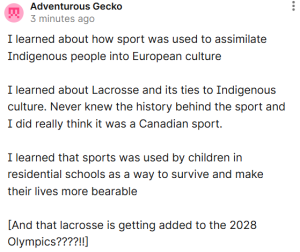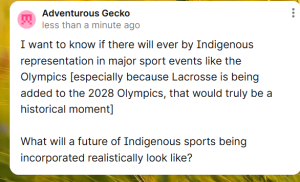4
These are difficult stories. We bear witness in this chapter to the role of sport in furthering the settler colonial projects throughout Turtle Island. Here are some supports to access in the community and from a distance:
First Peoples House of Learning Cultural Support & Counselling
Niijkiwendidaa Anishnaabekwag Services Circle (Counselling & Healing Services for Indigenous Women & their Families) – 1-800-663-2696
Nogojiwanong Friendship Centre (705) 775-0387
Peterborough Community Counselling Resource Centre: (705) 742-4258
Hope for Wellness – Indigenous help line (online chat also available) – 1-855-242-3310
LGBT Youthline: askus@youthline.ca or text (647)694-4275
National Indian Residential School Crisis Line – 1-866-925-4419
Talk4Healing (a culturally-grounded helpline for Indigenous women):1-855-5544-HEAL
Navigating Chapter Four
Part One Introduction: Fundamentals
Please read Chief Justice Murray Sinclair et al., Chapter 15 of Part One The Final Report of the Truth and Reconciliation Commission of Canada (Volume One). 15. Recreation and Sports: 1867-1939 (pp. 353-374).
https://nctr.ca/wp-content/uploads/2021/01/Volume_1_History_Part_1_English_Web.pdf
Exercise 1: Notebook Prompt
We are asked to honour these stories with open hearts and open minds.
Which part of the chapter stood out to you? What were your feelings as you read it? (50 words)
| Honestly I felt uncomfortable reading this chapter. Knowing what I do about residential schools, it’s so odd to see how they’re described as just regular schools. The chapter talks about how life at residential school included chores, school work, vocational training and religious activities were apart of the school schedule. From the outside looking in it seems normal, having the same activities that schools in this day have. On a surface level these activities are normal but deep down knowing the pain and suffering these children went through is hard to come to terms with. It’s also interesting to see a lot of the activities describes because at the end of the day these seemingly ‘fun’ activities were used to forcefully assiminate Indigenous children into european culture.
|
Part One
Section A: Keywords
https://padlet.com/kellymcguire/keywords-for-chapter-four-f759u6b97m25z4md
Exercise 2: Padlet Prompt
Briefly define (point form is fine) one of the keywords in the padlet (may be one that you added yourself).
| Settler colonialism is the practice of settlers from another country or place, settle on land that belongs to Indigenous people. The main objective of settler colonialism is to make settlers indigenous. This process required two things. The first being a total erasure of Indigenous communities that were there before. A lot of these communities were displaced because of settler colonialism. The second part required the group that has settled to eventually form a single national entity. |
Section B: Truth and History
Section C: Settler Colonialism
Exercise 3: Complete the Activities
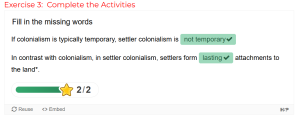
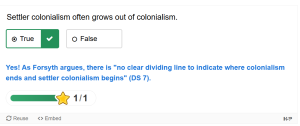
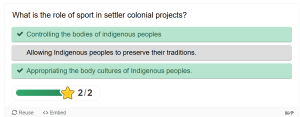
Exercise 4: Notebook Prompt
Although we have discussed in this module how the colonial project sought to suppress Indigenous cultures, it is important to note that it also appropriates and adapts Indigenous cultures and “body movement practices” (75) as part of a larger endeavour to “make settlers Indigenous” (75).
What does this look like? (write 2 or 3 sentences)
| The process of appropriation and adaptation includes settlers taking parts of Indigenous culture and taking away their meaning and making it their own. Settlers are claiming these practices and traditions as their own which goes towards the agenda of settlers becoming indigenous to the land, even though there were settlers before them. |
Section D) The Colonial Archive
Exercise 5: Complete the Activities
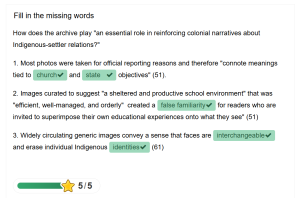
Section Two: Reconciliation
A) Reconciliation?
Exercise 6: Activity and Notebook Prompt
Visit the story called “The Skate” for an in-depth exploration of sport in the residential school system. At the bottom of the page you will see four questions to which you may respond by tweet, facebook message, or email:
How much freedom did you have to play as a child?
What values do we learn from different sports and games?
When residential staff took photos, what impression did they try to create?
Answer one of these questions (drawing on what you have learned in section one of this module or prior reading) and record it in your Notebook.
| As a child, I had a lot of freedom to play. I might not have had much people to participate with but I never faced any restriction when it came to play and being allowed to participate in different activies.
|
B) Redefining Sport
C) Sport as Medicine
Exercise 7: Notebook Prompt
Make note of the many ways sport is considered medicine by the people interviewed in this video.
|
D) Sport For development
Exercise 7: Notebook Prompt
What does Waneek Horn-Miller mean when she says that the government is “trying but still approaching Indigenous sport development in a very colonial way”?
| Waneek Horn-Miller’s statement means that even though efforts are being taken to support Indigenous sports, we’re still coming at it from a western perspective, or a colonial way, rather than considering an Indigenous approach. Thats why Indigenous leadership is important. Rather than trying and solve a problem, its better to look at it from a different perspective and work to create better solutions. Working alongside Indigenous people rather than solving issues for them. |
Exercise 8: Padlet Prompt
Add an image or brief comment reflecting some of “binding cultural symbols that constitute Canadian hockey discourse in Canada.” Record your responses in your Notebook as well.
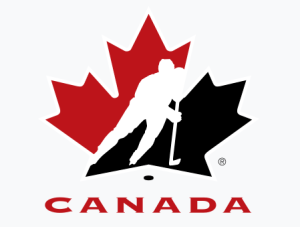
For me, this image represents how large hockey is intertwined with Canadian culture. Hockey is considered one of Canada’s national sport. It’s a sport that unites Canadian’s all around. It’s a time where we come together and celebrate our national pride.
|
Section Three: Decolonization
Please see the major assignment for this half of the term in the final section of this chapter.
Exit Padlet
https://padlet.com/kellymcguire/3-2-1-summary-uwc7qdg01vrj912c
